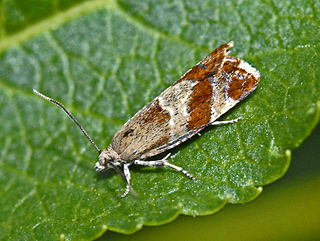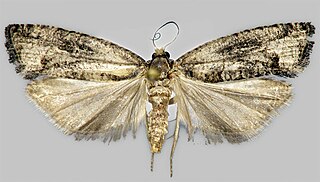
Epinotia ramella is a moth of the family Tortricidae. It is found in Europe, China, Japan, Russia and Kazakhstan.

Epinotia immundana is a moth of the family Tortricidae. It is found in China (Qinghai), Russia and Europe.

Epinotia solandriana is a moth of the family Tortricidae. It is found in Europe, China, Korea, Japan, and Russia.

Epinotia is a very large genus of tortrix moths. It belongs to the tribe Eucosmini of subfamily Olethreutinae.

Epinotia cruciana, the willow tortrix, is a moth of the family Tortricidae.

Epinotia nanana, the European spruce needleminer, is a moth of the family Tortricidae. It is found from northern and central Europe to Russia and Mongolia.
Epinotia rubiginosana is a moth of the family Tortricidae. It is found from Europe to eastern Russia, China, Korea and Japan.

Epinotia signatana is a moth of the family Tortricidae. It is found from England and Scandinavia to the Mediterranean Sea, to eastern Russia, China, Korea, Burma and Japan.

Epinotia tenerana, the nut bud moth or alder tortricid, is a moth of the family Tortricidae.

Epinotia brunnichana is a moth of the family Tortricidae. It is found in most western, central and northern Europe, the Near East and further east to the eastern Palearctic realm, where it has been recorded from Russia, Kazakhstan, China, and Japan.

Epinotia maculana is a moth of the family Tortricidae. It is found in most of Europe, east to the eastern part of the Palearctic realm.

Epinotia meritana, the white-fir needle miner, is a moth of the family Tortricidae. It is found in the western United States, including Utah, New Mexico and Arizona.

Crocidosema lantana, the lantana flower-cluster moth or lantana tortricid moth, is a moth of the family Tortricidae. It was first described by August Busck in 1910. It is native to Mexico and the southern United States, but was introduced to Hawaii in 1902, Australia in 1914 and the Caroline Islands in 1948 and 1949 to aid in the control of Lantana weeds. It has also been recorded from Yunnan, China and in Sri Lanka.

Epinotia trigonella, the birch epinotia moth, is a species of moth of the family Tortricidae. It is found in most of Europe, east to the eastern Palearctic realm. It is also found in North America.
Epinotia javierana is a species of moth of the family Tortricidae. It is found in Argentina.

Epinotia thapsiana is a moth of the family Tortricidae. It was described by Philipp Christoph Zeller in 1847. It is found in the Netherlands, France, Spain, Portugal, Switzerland, Austria, Italy, Slovakia, Hungary, Slovenia, Serbia, North Macedonia, Albania, Greece, Russia, Asia Minor, Iran, Kyrgyzstan, Tajikistan, Turkmenistan, China and Korea.
Epinotia tenebrica is a species of moth of the family Tortricidae. It is found in Morona-Santiago Province, Ecuador.
Epinotia illepidosa is a species of moth of the family Tortricidae. It is found in Morona-Santiago Province, Ecuador.

Epinotia nemorivaga, the bearberry bell, is a species of moth in the family Tortricidae. It is found in Europe and Asia.

Epinotia caprana is a moth belonging to the family Tortricidae. The species was first described by Johan Christian Fabricius in 1798.















